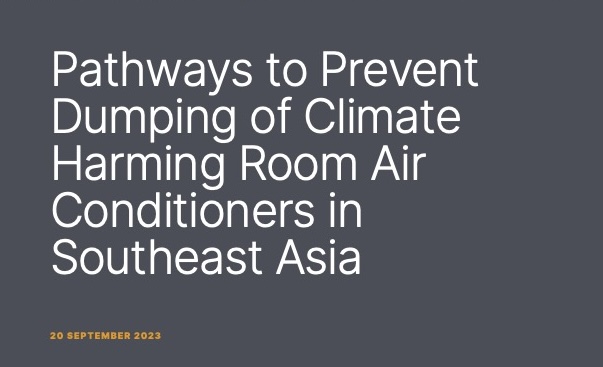*
“New but energy-inefficient cooling appliances that are dumped in climate-vulnerable developing countries are ‘energy vampires’ that steal the energy these countries need for development.” – Durwood Zaelke
What is Environmental Dumping of Cooling Equipment?
Since the ozone-depleting substance (ODS) phaseout and phasedown schedules were codified in the Montreal Protocol, cooling equipment manufacturers and refrigerant producers have sought ways to exploit the fact that developed and developing countries were given “common but differentiated” responsibilities and different schedules for stopping the production and consumption of refrigerants that harm the ozone layer and cause warming. Despite known impacts on climate and the ozone layer, corporations continue to sell inefficient cooling equipment to developing countries, taking advantage of the fact that these countries are permitted to use obsolete equipment for several more years.
The term “environmental dumping” describes manufacturers in developed countries selling cheap cooling equipment abroad that the Montreal Protocol prohibits them from selling in their home countries.
How Does Environmental Dumping Harm Developing Nations (and All Nations)?
When consumers in developing countries are lured into purchasing inefficient and obsolete cooling equipment due to low prices or simply because better choices are unavailable, they are falling prey to an economic trap that harms:
- Citizens’ personal well-being
- Community health and prosperity
- Their country’s climate resiliency and responsibilities under the Montreal Protocol and its Kigali Amendment
- Air and water quality and the natural environment
Dumped cooling equipment relies on old technology and uses more electricity, which means high utility bills for consumers. In most developing countries, electricity is generated from burning fossil fuels, so more installations of inefficient cooling equipment means more climate-warming CO2 emitted from power plants to the atmosphere. Money spent on replacement cycles of marginally better cooling equipment could instead be used for local infrastructure improvement, public services, and education. And with each replacement cycle, more ozone-depleting and/or climate-damaging refrigerants will be emitted to the atmosphere because reuse is impossible and proper destruction is expensive.
A huge economic opportunity exists for forward-thinking enterprises: bring affordable, super energy-efficient, best technology cooling equipment to the marketplaces of vulnerable developing countries.
Has There Been Progress in Stopping Dumping?
The marketing to developing countries of new but energy-inefficient cooling equipment that uses refrigerants with high global warming potential (GWP) has been a concern of the Montreal Protocol for years. IGSD has been at the forefront of efforts to stop this practice, develop innovative solutions, and inspire champions:
- In 2018, IGSD developed the legal framework for stopping dumping, which was published in the Duke Law Journal.
- In 2020, CLASP and IGSD documented evidence of environmental dumping of cooling equipment in Africa in the study Environmentally Harmful Dumping of Inefficient and Obsolete Air Conditioners in Africa.

Source: Environmentally Harmful Dumping of Inefficient and Obsolete Air Conditioners in Africa (CLASP and IGSD, 2020)
- In 2023, CLASP and IGSD collaborated on the study Pathways to Prevent Dumping of Climate Harming Room Air Conditioners in Southeast Asia.

Source: Pathways to Prevent Dumping of Climate Harming Room Air Conditioners in Southeast Asia (CLASP and IGSD, 2023)
To help with the development of policy and enforcement solutions, CLASP and IGSD continue to build the evidence base for environmentally harmful dumping of cooling equipment. A future report will focus on cooling equipment offered in Latin America and the Caribbean.
Explore the timeline below to see the progress made in the fight against dumping.
Environmental Dumping Resources






